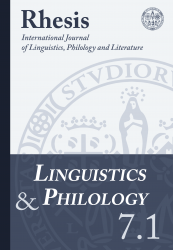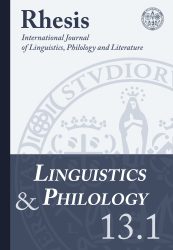 Linguistics and PhilologyVol. 7.1 - 2016
Linguistics and PhilologyVol. 7.1 - 2016Table of contents
| p. 5 | IntroduzioneFederico Alpi, Roberto Batisti, Valeria Melis Abstract Atti del Workshop Internazionale “Contact Phenomena Between Greek and Latin and Peripheral Languages in the Mediterranean Area (1200 B.C. – 600 A.D.)” |
| p. 9 | L’invenzione dell’alfabeto armeno: fatti e problemiAlessandro Orengo Abstract At the beginning of the 5th century AD, when Armenia was still an independent state, a clergyman named Maštocc (also known as Mesrop), decided to give his people a script, involving in this project his Patriarch, Sahak, and his King, Vṙamšapowh. They soon found out that a script for the Armenian language already existed, and that it had been discovered by and was in the possession of a Syriac Bishop named Daniēl. This alphabet was requested and obtained from him, but, according to some sources (Koriwn, Movsēs Xorenacci), it proved inadequate for rendering the sounds of the Armenian language. Maštocc was consequently compelled to continue his work. Another source (Łazar Pcarpecci) argues instead that the script obtained from Daniēl proved suitable on the whole, and just required some minor adjustments. It is possible that all our sources actually describe the same process, focusing to different degrees on the genuine contribution of the Armenian team. In any case, it is quite sure that these adjustments involved creating signs for the vowels, which were probably not present in the script possessed by the Syriac Bishop. After the creation of the Armenian alphabet, all sources agree in saying that a huge translation activity began. |
| p. 28 | Problematising the Greek Influence on Armenian TextsIrene Tinti Abstract It is generally acknowledged that the Greek language and culture exerted a notable and durable influence, especially on learned Armenian milieux. However, the full effect of these ties has often been recognised mainly in cultural and literary niches, such as those responsible for the most slavish translations of Greek specialised texts, which are generally perceived as clearly distinct both from ‘Classicalʼ versions and from the more genuine Armenian production. The present paper adheres instead to more recent trends of thought: it addresses the topic of the Greek influence on Armenian by underlining its continuity through time and textual typologies, thus avoiding clear-cut and strictly chronological periodisations, without denying the reality of language change. Indeed, since several factors, including but not limited to foreign influences, can affect internal variation, the separation between translated and original literature on the one hand, and between different ˗ and internally homogeneous ˗ schools of translators on the other, should not be overemphasised. Within this context, the paper also addresses the problematic nature of some widely used labels, such as Classical Armenian and Hellenising School. |
| p. 44 | Οὐδὲ τῆς διαλέκτου τῆς σφετέρας ἔτι μεμνημένοι: the disappearance of indigenous languages in Republican IberiaBenedict Lowe Abstract Strabo writes that the Turdetani had become so imbued with Roman ways as to forget their own language (3.2.15), a process he attributes to their receipt of Latin status and the arrival of Roman immigrants. This paper explores the mechanisms by which the use of the Latin language was adopted and the role of the Roman state in promoting its use. The paper focuses on three decrees issued by the Roman governors that date to the second and early first centuries BC: the decree of L. Aemilius Paulus dating to 190 or 189 BC and granting freedom to the inhabitants of turris Lascutana; the deditio of the community of the Seano[ ] to the imperator L. Caesius in 104 BC; and the adjudication by the governor C. Valerius Flaccus on 5 May 87 BC in a dispute between the Allavonenses and the Sosinestani. Rather than focusing on the symbolic value of these inscriptions, this paper suggests that they represent a far larger corpus of written communication between the Roman government and the provincial communities. The need of the provincial leadership to engage with the Roman legal system led to their co-optation into bringing about the Latinisation of the Peninsula and the disappearance of indigenous languages. |
| p. 56 | Greek, Latin and Palaeo-Balkan Languages in ContactDragana Grbić Abstract Focusing on the area of Danubian provinces of Roman Empire, this paper aims at touching upon linguistic diversity and language change in north-western Balkans in Roman epoch. Using epigraphic evidence, it will address the questions of the impact of the spread of Greek and Latin in this area, which led to a gradual extinction of the native, Palaeo-Balkan languages. In Antiquity, linguistic situation in this area was extremely complex: a great variety of languages came into close mutual contact and in contact with Greek and Latin, which became dominant. These Palaeo-Balkan languages are relict languages, and they are known almost exclusively through the onomastics recorded in Latin and Greek inscriptions and through rare glosses, i.e. by the time they came to be documented, their speakers were already Romanized or Hellenized. Most of the documents that record native onomastics are at the same time testaments of Romanization/Hellenization; however, these inscriptions bear witness that the native population preserved the memory of their ethnic and linguistic background. Key words: Illyricum, Palaeo-Balkan languages, onomastics, anthroponymy, native population, Romanization; |
| p. 66 | Riflessioni linguistico-storiche sul toponimo ‘Telese’: un exemplum di contatto fra osco, latino e greco.Giovanna Battaglino Abstract The paper gives an overview of the literary and numismatic attestations of the toponym ‘Telese’ – i.e. Tedis, Telesia (vetus), Τελεσία, Telesis (nova), Thelesia – by citing the fontes. The paper also offers space to the works of local history, which are concerned to the toponym of Telese (with particular attention to Petrucci’s History of Telese).The end of the paper proposes an etymological hypothesis, according to which exists a bond between the three linguistic and toponymic forms – i.e. the Oscan facies, the Latin facies and the Greek facies – through the common derivation from the Indo-European root *tel-2, *telǝ-, *telu-. |
Tags: 5th-century Armenia, Alessandro Orengo, Ancient Armenian, Ancient Greek, anthroponymy, Armenian script (invention), Benedict Lowe, Dragana Grbić, Epigraphy, etymological hypothesis, Federico Alpi, Giovanna Battaglino, Illyricum, internal variation, Irene Tinti, language contact, Latin language, Libero Petrucci, literacy, local history, native population, onomastics, Palaeo-Balkan languages, Roberto Batisti, Romanization, Telese, togati, toponymic study, translations, Valeria Melis

